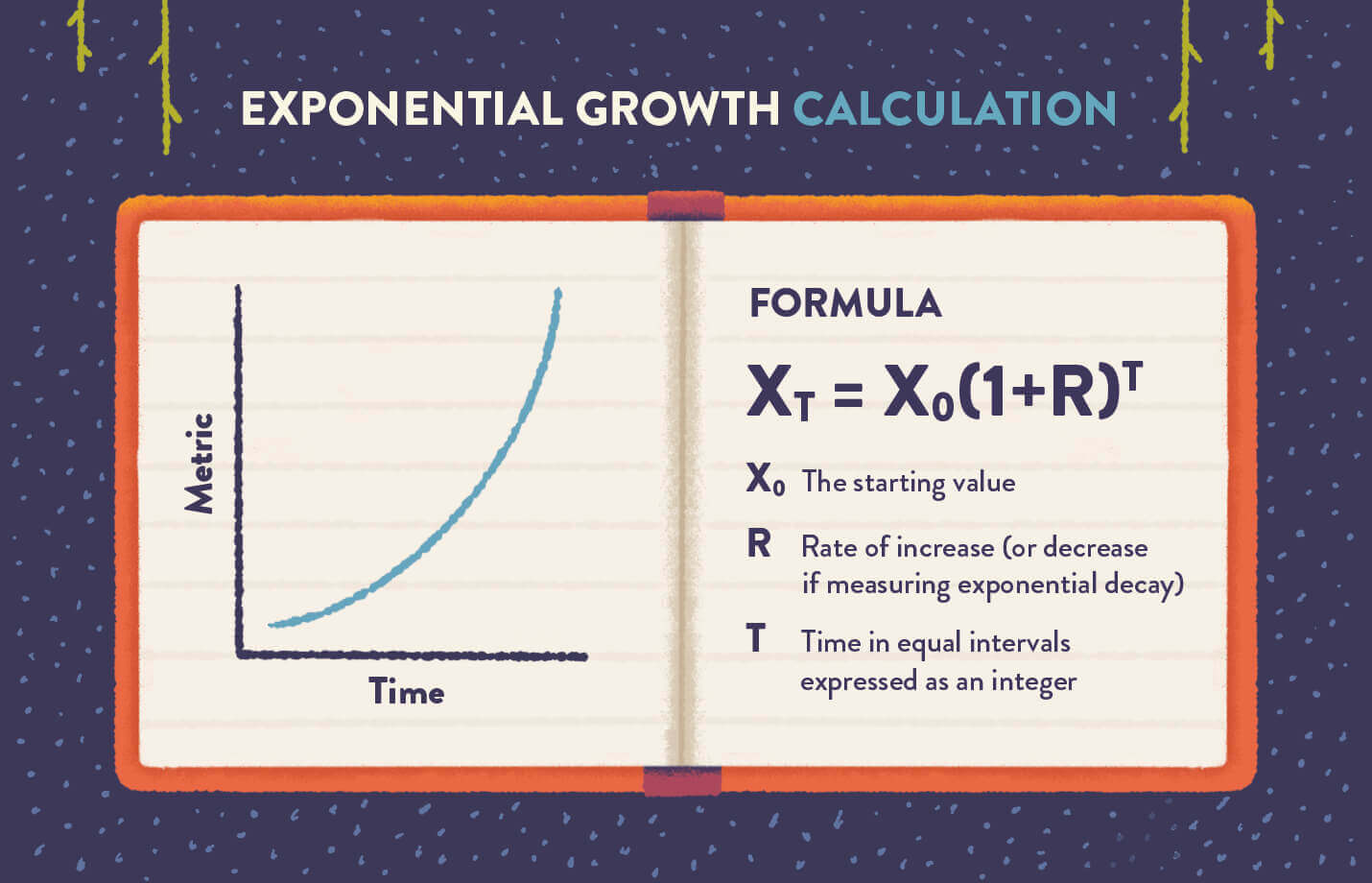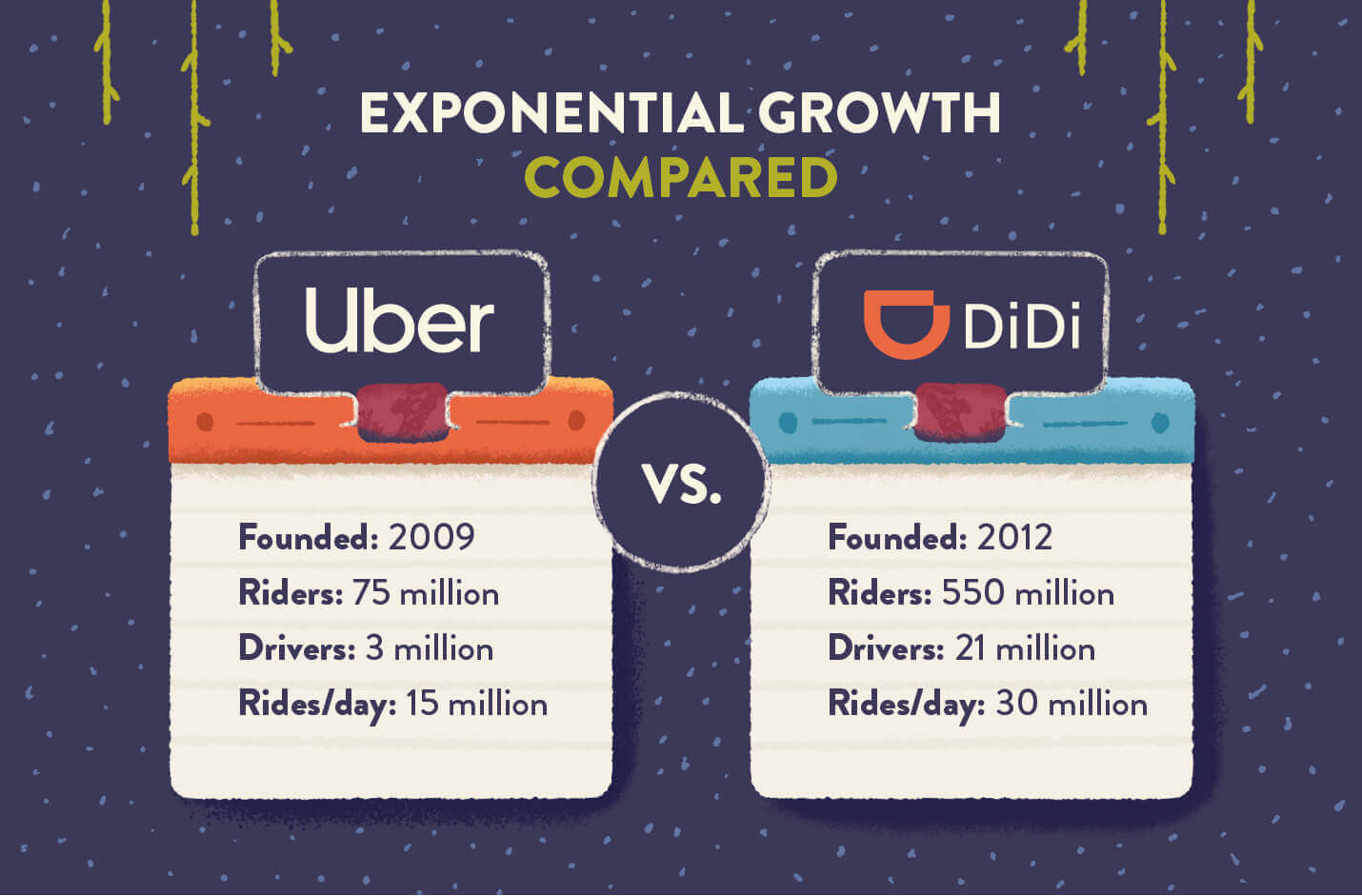What do Silicon Valley’s fastest-growing startups and the Manhattan Project have in common?
They both create bomb products that rely on exponential growth.
Okay, bad joke.
Exponential growth is synonymous with the startup buzzword “unicorn.” Every company you’ve heard referred to as this mythical creature is the product of exponentially fast growth.
The wheat and chessboard problem is a great demonstration of the power of exponential growth. Let’s say you start with one grain of wheat in the first square of an 8×8 chess board. If you double the amount of rice with each subsequent square, by the 64th square you’d have 18,446,744,073,709,551,615 or 18 quintillion grains of wheat. That’s a lot of bread.
What is the science behind this immense power and how can you harness it for your business? Let’s get under the hood of exponential growth in this article or jump straight to our infographic below.
Exponential Growth Defined
Exponential growth is the rate of change measured over a given number of equal time intervals. Basically, when a business grows by 100% (or doubles) over multiple time intervals, each increase of 100% is added to the starting value, resulting in compounding and an environment of exponential growth.
This means that even if you grow 100% per year, it is not necessarily exponential growth. But if you grow 100% every year over many years, you would begin to experience hypergrowth.
Exponential Growth Formula
The formula for exponential growth begins by taking the starting value of whatever metric you are measuring—for example, revenue or number of users. Then you evaluate the percent increase over a given duration of time.
The final component in the formula for exponential growth is the exponent itself. The exponent, in this case, is the number of equal time intervals being measured. Here is the formula for you mathematically inclined folks out there:
Xt = X0(1+r)t
X0 = the starting value
r = rate of increase (or decrease if measuring exponential decay)
t = time in equal intervals expressed as an integer

Exponential Growth Example
Let’s take your app as an example.
We will compare a 10% growth rate to a 100% growth rate.
In the first year, your app acquired 500 users. In year two, the number of customers increased by 10%, adding 50 new users for a total of 550 users at year’s end. If this growth continues, how many users do you think you will have after five years?
500(1+0.1)5
Xt = 805 users
A mere 805 users.
But how different would this number be if you achieved exponential growth of 100% year over year for that same five year period?
500(1+1)5
Xt = 16,000 users
As you can see, achieving exponential growth makes a huge difference. In this case, that difference would be 15,195 users—to be annoyingly precise.
What Spurs Exponential Growth?
One of the biggest facilitators of exponential growth in marketing is the idea of viral coefficients. Sometimes used interchangeably with going “viral,” the viral coefficient takes advantage of word-of-mouth marketing.
If every single customer invites 10 people within their network to use a product or company, exponential growth is all but inevitable.
Then the network effect takes over. This is where the product becomes more useful as more people use it. Instagram, for example, would not be very interesting if only a handful of people posted pictures.
As increasingly more people join and post their pictures, they bring with them their friends, families, and fans.
Examples of Exponential Growth in Business
You’ve heard of them, you’ve probably used them, and you’ve probably told your friends about them.
That’s right. You could be partially responsible for the exponential growth of companies like Facebook, Instagram, Uber, and Airbnb—or Snapchat if you are Gen Z.
Probably the best example of exponential growth is Facebook’s monthly active users (MAU). At the end of 2004, Facebook had 1 million MAUs and at the end of 2018 that number had risen to 2.32 billion.1
This is a 231,900% increase over the 14 year period.
Facebook’s revenue growth from 2004 is an even more impressive percentage. Revenue in 2004 was a dismal $400,000. But in 2005, revenue grew to $9 million, a 2,150% increase. Fast forward to 2018 where Facebook brought in $55 billion in revenue.2
This is a mind-blowing 13,753,150% increase over the same 14 year period.
DiDi
Okay, you might not have heard, used, or told anyone about this next example but if you want to talk about exponential growth, you can’t avoid China.
DiDi is China’s ride-hailing Uber alternative. Although it was started in 2012 and is likely a casualty of China’s complete disregard for Silicon Valley’s intellectual property, DiDi has grown to eclipse Uber’s usage statistics.
Let’s start with some Uber usage stats. Founded in 2009, Uber has 75 million users, employs 3 million drivers, and completes more than 15 million rides per day. Not bad for a 10-year-old company.
DiDi, on the other hand, has 550 million users, employs 21 million drivers, and completes 30 million rides per day. Impressive when you consider Uber had almost a 3-year head start.3
Strategies to Achieve Growth Exponentially
By now you’re probably chomping at the bit to get your hands on some sweet exponential growth. But how?
Like viral marketing, successfully achieving exponential growth in the real world is no easy task. If only you could plug your desired growth rate into the equation and model it into the future.
Scaling your business to grow 10x starts with building great products and continues if you can build habits for your users.
Take Nanna’s Experience to the Nth Power
If your products are complicated and confusing to use, you risk alienating a large majority of potential users and driving users to uninstall your app before exponential growth has time to work its magic.
Some people advocate for the “Grandma Test” to determine how user-friendly a product is.4 We think this is a valid test for considering the exponential power of referral marketing. Why would we refer our grandmothers to use your products if we know they’re too confusing to use?
Building an amazing user experience is a process. It will likely come over the course of many version releases. User experience is an oft-overlooked aspect of growth, but in order to retain and engage users, you must provide a memorable experience that will inspire users to come back.
Don’t Forget About the Onboarding Experience
With all that focus on the highest quality leather interior so grandma will be comfortable for the ride, don’t forget to provide her a step ladder to get in.
The best user experience in the world will have been for nothing if users are not brought up to speed on how to use the product. Whether it’s an intuitive onboarding education or a guided onboarding, it’s important you look into the golden rules of onboarding to optimize this first impression for new users.
Incentivize Referrals and Social Sharing
How will grandma remember to tell her friends at her weekly bridge game how easy and useful your app is if you don’t remind her?
Implement a refer-a-friend program for existing users to incentivize a word-of-mouth recommendation within their network. Creating a mutually beneficial referral marketing program encourages participation.
Even though a mutually beneficial referral program is advantageous for both parties, it can feel more like bribery than an organic recommendation. Social sharing, on the other hand, can feel less forced and more organic.
Provide users with a visualization of their usage data or something that would appeal to their social media followers and also their ego. A usage dashboard, for example, is commonly used by exercise tracking apps as a means for users to show off their performance.
Add Value, Not Just Vertisements
Is vertisements even a word? What are we adding when we advertise?
Too often, we use push notifications, SMS marketing, email marketing, and other mediums to advertise our latest features or simply promote the use of our product. This onslaught of messages can overwhelm and annoy users.
In fact, we recently found that 28% of users uninstall apps because they receive excessive advertisements and notifications
Pivot your marketing strategy to provide users with valuable insights, time-sensitive updates, or breaking news. Airbnb does a good job of creating a sense of urgency without feeling intrusive by simply notifying users if demand spikes in the locations they have been researching.
Built to Scale
Is your business model scalable?
In other words, does an increase in demand result in an equivalent increase in the effort to fulfill that demand?
The service industry is a great example of this. A waitress is not able to serve exponentially more tables. In fact, after her capacity is reached the restauranteur is forced to bring in another waiter or turn away business. This is a linear growth model and not scalable to the exponential level.
If you want to achieve exponential growth, make sure you do not have any variables in the business model that will constrict your ability to scale profitably. Ask yourself if you are able to allocate more resources to real-time increases in demand.
Let’s take Uber as an example. When Uber sees a spike in demand they cannot simply allocate more resources—in this case, drivers. To combat this problem, they implement surge pricing, which reevaluates the supply and demand curve, bringing the price and profitability per ride up.
Exponential Decay
There is a dark side to exponential growth, and that is exponential decay.
Self-aware businesses understand that companies don’t last forever. Just like living beings, companies grow from their infancy into maturity and eventually die. The businesses with the greatest longevity have all faced inevitable extinction in one way or another but have been able to pivot their strategy to maintain success.
Whether it’s a new product to come out of research and development or an entirely new business model through mergers and acquisitions, companies must understand the dynamic environment they serve.
As your business matures, it’s vital to understand the precariousness of the seat upon which your business is perched—because the higher you climb, the farther you have to fall. Some of the fastest growing companies in history have met with equally fast decay.
To grow exponentially without risking exponential decay, keep your ear to the rail, and your finger on the pulse to stay relevant in your industry. Use our benchmark reports and other mobile marketing resources to harness the power of exponential growth. 

See how today’s top brands use CleverTap to drive long-term growth and retention
Subharun Mukherjee 
Heads Cross-Functional Marketing.Expert in SaaS Product Marketing, CX & GTM strategies.
Free Customer Engagement Guides
Join our newsletter for actionable tips and proven strategies to grow your business and engage your customers.

















































